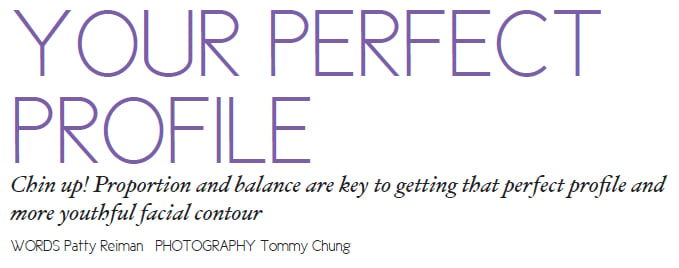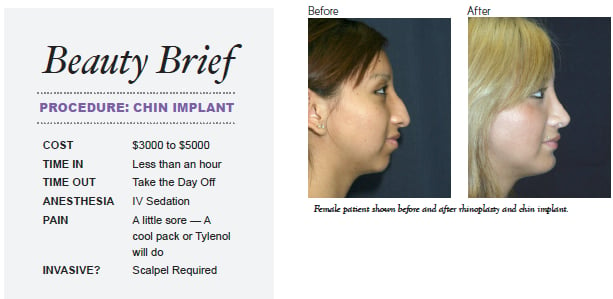A nose that’s too big. Neck skin that sags. To the untrained eye, you might think that’s the issue you want to correct, but the real culprit? It just might be your chin.
Having a smaller chin that is out of proportion with the surrounding facial features is not uncommon. And even balanced faces can fall victim to the aging process, which can result in diminished bone density and facial fullness over time. But a chin implant can address both of these issues—with or without an accompanying facial rejuvenation procedure like rhinoplasty (nose job) or a chin or neck lift.
The role of the chin implant in achieving facial balance and overall profile is something that comes up fairly often in the cosmetic surgeon’s office. “The majority of patients who will have chin implants are not initially aware of the importance of the procedure in enhancing their overall facial profile and structure,” says Mohsen Tavoussi, MD, DO, a board-certified facial plastic surgeon and member of the American Academy of Cosmetic Surgery (AAC S) who practices in Huntington Beach, Calif. “They usually are seeking rhinoplasty or rejuvenation of the lower face and neck.”
Faisal A. Quereshy, MD, DDS, a board-certified cosmetic surgeon who practices in Medina, Ohio, agrees. “The cheeks and chin are pillars of the face with the highest bone density,” he explains. “Just like any other bone in the body, the chin loses bone volume and mass over time, and soft tissue is not supported as well. That accentuates sagging around the jowls and neck.”
To address facial balance and soft tissue loss, both doctors use three-dimensional computer imaging before surgery to give patients a realistic—but approximate—idea of how they will likely look after chin implant surgery.
“We look at the face as a whole, and patients rely on our expertise. The nose, lip and chin should all balance,” advises Dr. Quereshy. This was the case with Connie Mantz, Dr. Quereshy’s patient, who consulted with him about liposuctioning her neck area.
“He agreed with the liposuction but also brought to my attention that my chin was not as strong as it could be. It made sense to do the added procedure to get the full result I was looking for,” recalls Connie, who had the procedures four years ago at age 42. “Even though liposuction would have made me feel 100 percent better, just knowing about the symmetrical view of things makes me feel I made the right choice to enhance this area further.”
Dr. Quereshy finds that most younger patients in their late teens or early twenties can get by with just a chin implant to improve appearance, but older patients often require an accompanying procedure to address jowls, sagging cheeks or wrinkling. Dr. Tavoussi most often combines a chin implant with rhinoplasty.
“Once a chin implant is performed, the nose will look smaller, and various parts of the facial skeleton become more harmonious,” Dr. Tavoussi tells his chin implant patients, whose ages range from 18 to 68 and beyond.
When paired with another procedure, a chin implant sometimes requires a general anesthetic. But more often, and certainly if it is done alone, IV sedation is sufficient.
Placing the implant could take about 45 minutes and cost between $3,000 and $5,000, depending on type of anesthesia, surgery site fees and implant material used. Choice of implant material varies, as does the size and shape of the implant. Individual selection is based on the facial deficiency being addressed and the results desired and agreed upon by the patient and cosmetic surgeon. Dr. Quereshy most often uses silicone because, “it feels most like bone and holds its position long term.”
Dr. Tavoussi agrees that soft, solid silicone is the most common implant, but other choices include hydroxyapatite, expanded
polytetrafluoroethylene (Gore-Tex) or folded mesh of a non-absorbable material.
To improve chin and jowls, Dr. Tavoussi suggests a wraparound implant that adds bone volume to the chin front and sides where the jawbone meets it and can appear notched. “Fat can be injected for minor deformities but has limited long-term survival,” he notes.
Research studies have followed chin implant patients for about five to 10 years with good longevity results. Dr. Quereshy has performed repeat chin implants in patients whose original implants were placed 20 years prior. Most often the implants have shrunk or shifted.
“I had concerns it would move and become dislodged and had to get used to the idea of having something permanently affixed,” Connie remembers. “It’s under muscle and tissue and is undetectable. My chin feels like a normal chin. I’m very satisfied. I don’t even know that it is there.”
The Procedure Download
Only a small incision of just slightly longer than an inch located just behind the chin crease is required. Another option that has a slightly higher risk of infection (due to oral bacteria) is an incision through the lower gum when no other facial procedure is needed.
After inserting the implant through the incision, the cosmetic surgeon attaches it to existing bone with permanent sutures or microscrews.
Dr. Quereshy evaluates the patient’s chin appearance and projection while he or she is still lying on the operating table and can adjust the implant shape or size before closing the surgery site. “There is little swelling, so you can see results on the table,” he explains.
What little swelling or bruising may occur usually decreases with in two weeks after surgery. Over-the-counter pain medications usually control any mild discomfort, and there may be some elastic dressing covering the surgery site. Connie described her pain level as “very low.”
“You will have some temporary numbness in the chin and possibly lower lip, but nothing serious or hindering in any way. I recall feeling a little tightness when turning my head. Dr. Quereshy told me I was babying it too much,” says Connie.
Is A Chin Implant Right For You?
Dr. Tavoussi suggests consulting with a cosmetic surgeon and gathering information available on the Internet. Come to the consultation prepared with questions written down.
“Ask as many questions as you wish. Educate yourself. A good patient is a well-informed patient,” he advises. Dr. Quereshy agrees. “The better informed patients are, the better results we’ll get.”
He advises selecting only a board-certified cosmetic surgeon who performs procedures in an accredited surgical facility. “Choose a surgeon who is well versed in facial procedures,” he says. “Others may do a lot of body work. Ask for before and after patient photos.”
What is Connie’s advice? “Go for it. It’s like icing on the cake.”













